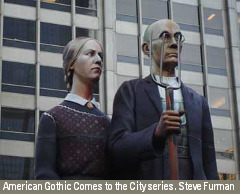Postmodernism 11 - Preaching to Postmoderns
 From Sunesis. Posted with permission. Read the series so far.
From Sunesis. Posted with permission. Read the series so far.
The postmodern church began as a reaction to the megachurch movement and the impersonality of the big churches. The emerging churches all started small and promoted the superiority of their smallness. That is not heard so much anymore, now that some emerging churches have become the next megachurches. Some of the postmodern church members and leaders may not be believers; this is obvious as you look at some of their beliefs. There are, however, some believing postmoderns; there should and could be many more. Most postmoderns are outside any type of church. We have a great opportunity to evangelize them.
Postmoderns like groups, and there is much to be said for the use of small groups in reaching the postmodernist. Those who are truly postmodern still value the group and the group mentality. Small group Sunday Schools (perhaps too formal for some postmoderns) and home-based small groups (more inviting for the postmodern) can be used effectively to reach this group (and moderns, as well).







 Posted with permission from
Posted with permission from 
Discussion